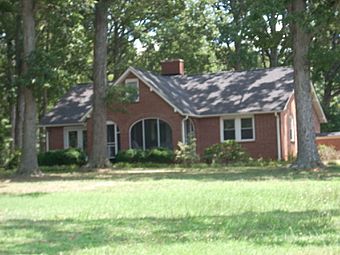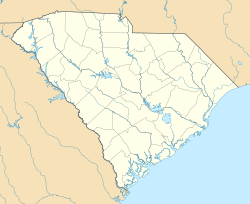McPhail Angus Farm facts for kids
Quick facts for kids |
|
|
McPhail Angus Farm
|
|

John A. McPhail House
|
|
| Location | Oconee County, at 320 Coyote Lane off Pine Grove Road |
|---|---|
| Nearest city | Seneca, South Carolina |
| Area | 209.7 acres (84.9 ha) |
| Built | 1902 |
| Architectural style | Bungalow/Craftsman |
| NRHP reference No. | 07000396 |
| Added to NRHP | November 7, 2007 |
The McPhail Angus Farm is a historic farm located near Seneca, South Carolina, in Oconee County. It is also known as the Tokena Angus Farm. This farm was added to the National Register of Historic Places on November 7, 2007. It is important because it shows how farms in Upstate South Carolina changed from growing cotton in the 1800s to raising cattle in the 1900s.
Farm History: From Cotton to Cattle
The McPhail Angus Farm has a long and interesting history. It shows how farming changed over time in South Carolina.
How the Farm Started
John Augustus McPhail (1876–1961) bought the first part of this farm in 1902. It was about 150 acres (61 ha) big. People think this land was once part of a larger plantation owned by Samuel Earle, a hero from the American Revolutionary War. Over the years, more land was bought, and by 1931, the farm grew to 468 acres (190 ha).
Walter McPhail's Vision
Walter Hoolu McPhail (1901–1979), John's oldest son, moved to the farm in 1902 when he was a baby. He went to Tokeena School No. 1, which is now on the farm property. Walter became interested in cattle when he was only eight years old, after buying a young cow. Even though he started college at nearby Clemson College, he often came home to help plant cotton in the spring.
Changes in Farming
In the late 1920s, cotton prices dropped a lot. This happened because too much cotton was being grown, and then the Wall Street Crash of 1929 made things even worse. Many farmers struggled financially. Because of this, many people left their farms to find work in textile factories or with government programs like the Works Progress Administration during the New Deal.
The Rise of Angus Cattle
In 1936, Walter H. McPhail bought his first registered Angus cows. This was a big step! It helped create one of the first herds of black Angus cattle in South Carolina. To feed his cattle, he planted fescue grass in 1939. He got the seeds from a test plot in Anderson County. Fescue grass was great because it grew well in cool weather, providing food for the cattle. Eventually, the farm grew fescue not just for cattle food, but also to sell the seeds. This is how the farm changed from growing cotton to raising cattle and producing seeds.
Farm Recognition
The McPhail Angus Farm has received special honors. The Pendleton District Commission named it a South Carolina Century Farm. This means the farm has been owned by the same family for over 100 years. Also, the American Angus Association recognized its Angus herd as a National Historic Herd. In 2007, the farm was 249 acres (101 ha), with 194 acres (79 ha) included in the historic district.
Historic Buildings and Structures
The McPhail Angus Farm has eight important buildings and areas that show its history and architecture. These are called "contributing properties." There are also some newer buildings on the farm that are not considered historic.
John A. McPhail House
The John A. McPhail House was built around 1943. It's a one-story brick house with a strong concrete foundation. The wood around the doors and windows came from trees grown right on the farm! Over the years, the house was updated. In the 1950s, a new door was added for a beauty shop. This door was later changed to a French door in the 1990s. Another front entrance was added around 1962 and updated in 2000. The house was still being lived in as of 2007.
Jack Robinson Tenant House
This small, one-story house was built around 1890. It's made of wood with a special style called "board and batten" and sits on stacked rocks. Inside, the walls didn't have any covering. Even though it has windows now, it probably just had open spaces that might have been covered with parchment or animal rawhide. It has two rooms and a brick fireplace in the middle. The ceilings, most of the inside walls, and the chimney were painted white.
Norris Tenant House
This house is similar to the Jack Robinson house, also built with board and batten wood. Inside, many of the walls are covered with decorative wood panels called "bead board." Some panels are painted white, while others and the ceiling are a natural brown color. This house has four square rooms and a wide porch across the front. The brick fireplace is painted white up to the mantel.
Mule and Cattle Barn
This barn was likely built around 1886. It originally had unpainted wood siding and a metal roof. In the early days, this barn was home to the mules that worked on the cotton farm. The upper parts of the barn were used to store hay. In the early 1940s, a new section was added for the farm's cattle. Some of the mule stalls were changed into feeding areas for cows. In 1968, the outside wood was replaced and painted red. In the early 1990s, the roof was covered with tar to protect it.
Fertilizer and Truck Shed
This wooden shed was probably built around 1900. At first, it was used to store cotton for sharecropper families before it was processed at a cotton gin. It also stored commercial guano fertilizer. Later, it became a place to keep farm trucks. It was built with wood and had a metal roof, and its outside was painted white. After the roof fell in during a heavy snow in the early 1960s, the shed was rebuilt. Extra side sheds were added for more farm trucks. As of 2007, the shed was still used to store trucks and other farm equipment.
Corn Crib
This wooden building, called a corn crib, was built around 1900. It has wood siding and a metal roof. The bottom floor was used to store corn shucks. The upper level was for storing oats to feed the mules.
Chicken Coop
This wooden chicken coop has wood siding and a metal roof. One side is open but covered, and this is where the nest boxes for the chickens were. The enclosed part was for newly hatched chicks. It even had a wood-fired heater to keep the chicks warm until they grew feathers! Today, this former chicken coop is used to store equipment.
Terraced Agricultural Fields
The terraced fields on the farm were built when the land was used for growing cotton. These terraces follow the natural shape of the hills to stop soil erosion (when soil washes away). Now, these fields are planted with fescue, clover, and Bermuda grass to feed the cattle. The original fences were made of woven wire with barbed wire on top. Old Ford Model T car parts were even used as corner posts! Many of these fences have been replaced more recently.
Images for kids




